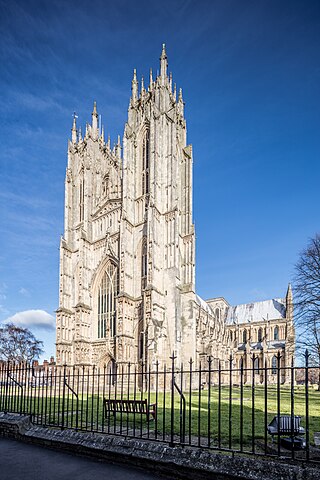
Beverley Minster, otherwise known as the Parish Church of Saint John and Saint Martin, in Beverley, East Riding of Yorkshire, is a parish church in the Church of England. It is one of the largest parish churches in the UK, larger than one-third of all English cathedrals and regarded as a Gothic masterpiece by many.

Minster is an honorific title given to particular churches in England, most notably York Minster in Yorkshire, Westminster Abbey in London and Southwell Minster in Nottinghamshire.
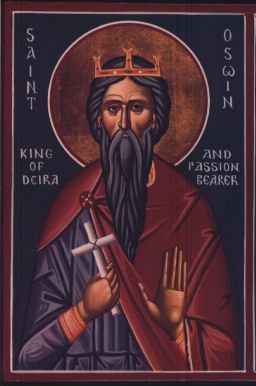
Oswine, Oswin or Osuine was a King of Deira in northern England.

Anglo-Saxon architecture was a period in the history of architecture in England from the mid-5th century until the Norman Conquest of 1066. Anglo-Saxon secular buildings in Britain were generally simple, constructed mainly using timber with thatch for roofing. No universally accepted example survives above ground. Generally preferring not to settle within the old Roman cities, the Anglo-Saxons built small towns near their centres of agriculture, at fords in rivers or sited to serve as ports. In each town, a main hall was in the centre, provided with a central hearth.

Ryedale is a non-metropolitan district in North Yorkshire, England. It is in the Vale of Pickering, a low-lying flat area of land drained by the River Derwent. The Vale's landscape is rural with scattered villages and towns. It has been inhabited continuously from the Mesolithic period. The economy is largely agricultural with light industry and tourism playing an increasing role.

Hilda of Whitby was a Christian saint and the founding abbess of the monastery at Whitby, which was chosen as the venue for the Synod of Whitby in 664. An important figure in the Christianisation of Anglo-Saxon England, she was abbess at several monasteries and recognised for the wisdom that drew kings to her for advice.

Tynemouth Castle is located on a rocky headland, overlooking Tynemouth Pier. The moated castle-towers, gatehouse and keep are combined with the ruins of the Benedictine priory where early kings of Northumbria were buried. The coat of arms of the town of Tynemouth still includes three crowns commemorating the tradition that the Priory had been the burial place for three kings.
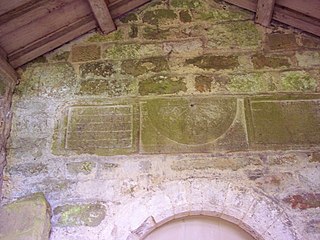
The Saxon sundial at St Gregory's Minster, Kirkdale in North Yorkshire, near Kirkbymoorside, is an ancient canonical sundial which dates to the mid 11th century.

Beadlam is a village and civil parish in the Ryedale district of North Yorkshire, England. According to the 2001 census it had a population of 250, reducing to 229 at the Census 2011. It is situated about 10 miles (16 km) west of Pickering, near the southern boundary of the North York Moors National Park. Beadlam is halfway between Helmsley and Kirkbymoorside on the A170.
York had around 45 parish churches in 1300. Twenty survive, in whole or in part, a number surpassed in England only by Norwich, and 12 are used for worship. This article consists of a list of medieval churches which still exist in whole or in part, and a list of medieval churches which are known to have existed in the past but have been completely demolished.

St Olave's Church, York is a Grade I listed parish church of the Church of England in York. It is situated on Marygate, by St Mary's Abbey.

Holy Trinity Church is a Church of England parish church in Westbury-on-Trym, Bristol, England.
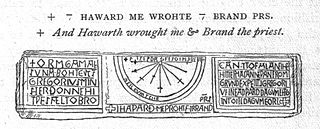
Kirkdale is a valley in North Yorkshire, England, which along with Sleightholmedale makes up the larger Bransdale and carries the Hodge Beck from its moorland source near Cockayne to the River Dove and onto the River Rye in the Vale of Pickering. Corallian Limestone which outcrops on the hills surrounding the Vale of Pickering runs across the region, and this appears as an aquifer in Kirkdale swallowing most of the water from Hodge Beck, which reappears further downstream. During summer months the river bed often runs dry as most of the water takes a subterranean passage.
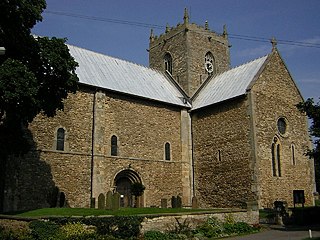
The Minster Church of St Mary, Stow in Lindsey, is a major Anglo-Saxon church in Lincolnshire and is one of the largest and oldest parish church buildings in England. It has been claimed that the Minster originally served as the cathedral church of the diocese of Lindsey, founded in the 7th century and is sometimes referred to as the "Mother Church of Lincolnshire".
Ellerburn is a village in the Ryedale district of North Yorkshire, England, situated near Thornton-le-Dale, about 3 miles (4.8 km) east of Pickering. It is located in the North York Moors National Park.

The Abbey Church of Saint Peter and Saint Paul, Monkwearmouth–Jarrow, known simply as Monkwearmouth–Jarrow Abbey, was a Benedictine double monastery in the Kingdom of Northumbria, England.

St Wilfrid's Church is an Anglican church in Halton-on-Lune, a village in the English county of Lancashire. It is an active parish church in the Diocese of Blackburn and the archdeaconry of Lancaster. Halton may have been the site of an ancient Anglo-Saxon minster. Of the current structure, the tower dates from the 16th century and the remainder was built 1876–77 by Paley and Austin. The church is recorded in the National Heritage List for England as a designated Grade II listed building.

A tide dial, also known as a Mass or scratch dial, is a sundial marked with the canonical hours rather than or in addition to the standard hours of daylight. Such sundials were particularly common between the 7th and 14th centuries in Europe, at which point they began to be replaced by mechanical clocks. There are more than 3,000 surviving tide dials in England and at least 1,500 in France.
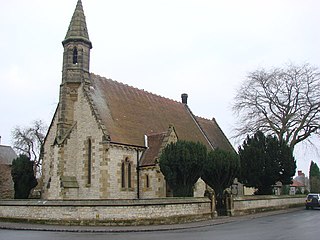
St Saviour's Church, Harome is a Grade II listed parish church in the Church of England in Harome, North Yorkshire.
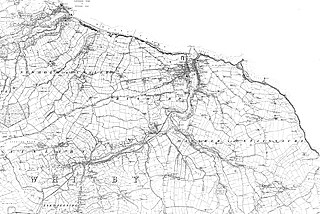
Aislaby Quarry is a sandstone quarry in the village of Aislaby, near to Whitby in North Yorkshire, England. The quarry produces sandstone which has been exported through Whitby to London and South East England.






























